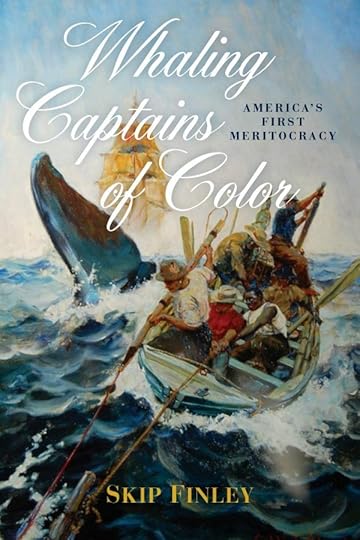Nonfiction Review: Whaling Captains of Color: America’s First Meritocracy
 American history has traditionally been written from a white and largely male-centric lens, but modern historians and researchers have been making strides to highlight the experiences and contributions of other people groups. The recently released Whaling Captains of Color is the culmination of one such study. Read on for the review.
American history has traditionally been written from a white and largely male-centric lens, but modern historians and researchers have been making strides to highlight the experiences and contributions of other people groups. The recently released Whaling Captains of Color is the culmination of one such study. Read on for the review.
Back Cover Blurb
The history of whaling as an industry on this continent has been well-told in books, including some that have been bestsellers, but what hasn’t been told is the story of whaling’s leaders of color in an era when the only other option was slavery. Whaling was one of the first American industries to exhibit diversity. A man became a captain not because he was white or well connected, but because he knew how to kill a whale. Along the way, he could learn navigation and reading and writing. Whaling presented a tantalizing alternative to mainland life.
The Review
In 2014, Skip Finley wrote a magazine article about William A. Martin, a black whaling captain who was based in Martha’s Vineyard. In researching this historical figure, Finley became fascinated by the history of people of color in the American whaling industry and did a deep dive into the subject. Whaling Captains of Color: America’s First Meritocracy is the result.
Like many historical narratives, the role of nonwhites has been downplayed or omitted in the annals of whaling. For instance, Finley mentions that William Crapo, founder of the Old Dartmouth Historical Society, insisted that the whaleman statue outside the New Bedford Public Library “depict a fair-skinned Yankee harpooner instead of a Gay Head Indian, a black man, or a Cape Verdean, even though they performed overwhelmingly in that role.” By delving into ship lists, logs, and genealogies, Finley brings to light the contributions and lives of people of color and the factors that led to their participation in such a dangerous occupation. And it was dangerous. The text mentions at least twice that whaling was America’s second most hazardous occupation. (Only mining was more dangerous).
However, in its early years, whaling was opportunity. In an era before petroleum, whale oil was the world’s energy source. And in pre-Civil War years, when discrimination against nonwhites abounded, a whaling ship was a rare place where a man of color could not only command respect but make his fortune.
The first part of the book details the oppression faced by blacks, Native Americans, and those of mixed blood in colonial and pre-Civil War America. It then describes the whaling industry and what life on board a whaler entailed. The book concludes with the slow decline of the industry. Even as petroleum replaced whale oil and plastic replaced whalebone, opportunities opened up for black Americans, and they left whalers to be replaced by Cape Verdeans, whose homeland was hit by multiple disasters in the nineteenth century.
While this book contains a lot of information about social conditions, the whaling industry, and individual whalemen of color, its organization leaves something to be desired. Scattered through the chapters are over fifty mini biographies of whaling captains and seamen. However, the context for fully appreciating their circumstances isn’t presented in the clearest fashion. In fact, Chapter 1 is simply a set of biographies (of a group of related captains) without any context other than what can be gleaned from the biographies themselves. The text has a tendency to refer to things in passing then discuss them in detail much later. For instance, numerous mentions are made of the Wampanoag in the first few chapters, but it’s not until page 90 that a description of that people group is provided. Overall, the book lacks a strong narrative arc and reads like a combined “Who’s Who” and encyclopedia of whaling.
Not to say that the book is without interesting moments. For instance, the biography of Henry John Gonzalez, the last known captain of color, includes colorful anecdotes connected to an Arctic expedition. However, information on the vast majority of whalemen are limited to countries of origin, birth and death dates, the ships they sailed in, and possibly a bit of genealogy, and the lack of detail unfortunately makes them less memorable. The way the biographies are ordered within the text also comes across as haphazard; if a system was used to designate their place in the book, it isn’t clear at all.
Ultimately, the book reads like an academic reference and probably will serve as a valuable resource to researchers. While there are no maps to orient the geography-challenged, there are tables aplenty detailing whaling data mined from various sources. Probably the strongest indicator that this was written for academics is the final chapter which closes with a series of blurbs about whalemen that Finley thought deserved additional study.
In Summary
This is definitely a scholarly text. While it contains information worthy of preserving for posterity, this is not a layperson’s text. Portions may prove handy for a student writing a history report or a genealogy study, but it is not a cover to cover read for the casual reader.
First published in The Fandom Post.



